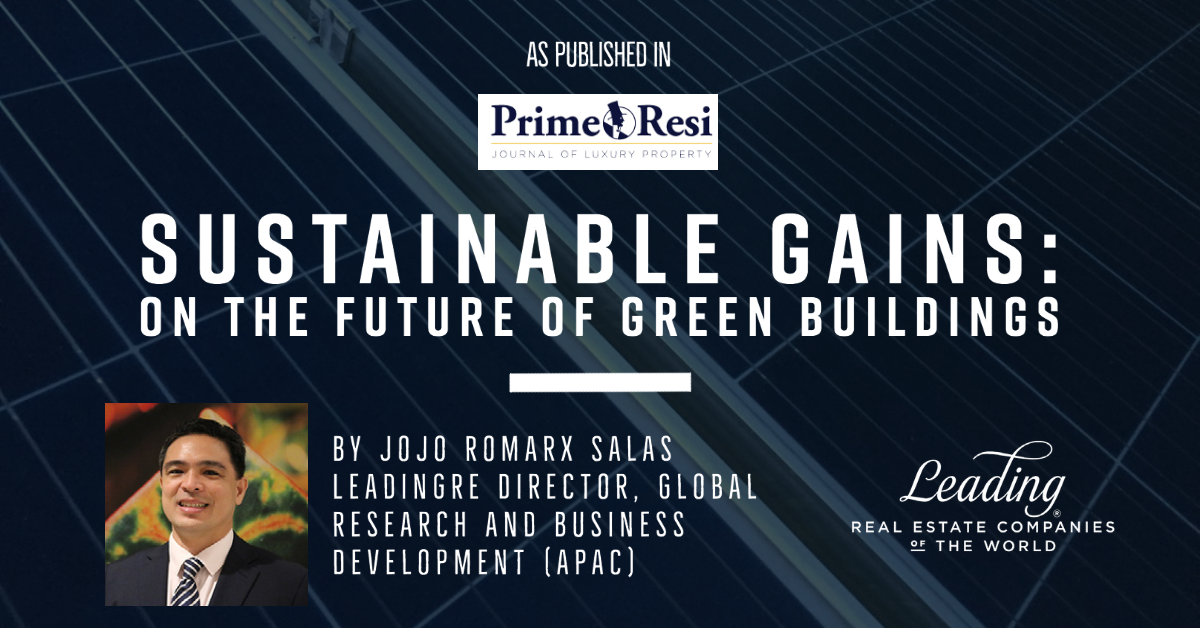
Originally published on PrimeResi (subscription required).
Developers, policymakers and investors are coming round to the idea that green development makes economic sense, says LeadingRE’s Jojo Romarx Salas.
“The floor area of the global buildings sector is expected to double by 2060,” according to the report “Green Buildings: A Finance and Policy Blueprint” by the International Finance Corporation, a sister organization of the World Bank and the largest global development institution focused on the private sector.
The projected growth may be a boon for the real estate and construction industry in general, but it could mean huge environmental costs. The IFC estimates that the buildings sector presently consumes more than half of all electricity, for heating, cooling and lighting and accounts for 28% of energy-related greenhouse-gas emissions. It will require an estimated 50% more energy by 2050 than today.
Climate change has prompted environmental considerations’ rise to the heart of all real estate decision-making, however, going green is also more profitable in the long run.
The IFC report states “resource-inefficient buildings run the risk of losing economic value or becoming stranded assets due to increasingly stringent regulations, pressure from financial regulators to manage and disclose climate risks, changing consumer preferences, and shareholder demands. Non-compliant buildings could become subject to legal action and fines, making them more expensive to operate and insure, and harder to lease or sell.”
There is a common notion that incorporating “green” or sustainable features in a development would mean additional costs, restricting profitability. This is not necessarily true, and there is a growing consensus that green development is not only more sustainable but more profitable as well. The IFC report presents that building green may result to savings of between 0.5% to 12% in construction costs. More importantly, green buildings can reduce up to 37% of recurring operational costs. Green buildings may achieve higher sale premiums of up to 31% with faster sale times. They can also have up to 23% percent greater occupancy rates, and higher rental income of up to 8%.
The initial impact of the Covid-19 pandemic has veered consumer demand towards health and wellness as well. With lockdown and quarantine all over the world, we reached out to our members, who reported a shift in tastes and preferences. Peter Thompson of Barfoot and Thompson, the LeadingRE member in Auckland, New Zealand said there is a growing concern for health and safety, especially when they transact real estate deals. Erik Noordam of VOC International in the Netherlands highlighted that there is an increased interest in wellness within buildings.
A LeadingRE member in California, Michael Hickman of Seven Gables Real Estate, said that due to the pandemic, more people are asking about recreational rooms, weight rooms, and larger spaces. LeadingRE noted a 500% increase in enquiries for tennis courts in Westchester County, New York. In Georgia, MaryJo Prater of Signature Properties Group noted that “lots of people are looking for waterfront homes.”
There is a consensus that “green and wellness” will be the trend in the coming years in developed markets. However, the IFC paper highlights the need for more “green” development in emerging markets and declares that “the green buildings sector represents a US $24.7 trillion investment opportunity by 2030 across all emerging market cities with a population of more than half a million people.”
Real estate investors and financiers can accelerate the market for green buildings. Typically, commercial banks are a key source of financing and fill the space on construction finance, mortgages, home improvement loans, and green financial products for resource-efficient buildings. Banks can expand their client base and product offerings, build higher-value and lower-risk portfolios, and access new sources of finance through green bonds, green securitizations, and green credit facilities, potentially reducing their cost of capital.
Governments, in turn, should create enabling environments to galvanize market growth by incentivizing financiers to channel capital to the sector, creating a pipeline of green building assets. Governments can also contribute to investor appetite by requiring all public buildings to be green. This will generate technical capacity and skills among designers, engineers, and workers, who then can build privately financed green buildings. Governments may also use fiscal incentives in the form of tax breaks, grants, subsidies, loans, and rebates.
The private sector’s voluntary commitment to build green is even more crucial. Due to the growing evidence of cost savings, as well as tax incentives, private real estate developers and owners have created the momentum to build green. Increased public awareness and collaboration with local and international rating systems can further fuel the growth of green building portfolio. With the stamp of verification from the likes of BREEAM, DNGB, EDGE, Green Star, and LEED, green developments will be supported with public acceptance as well as the financial benefits from savings and incentives.
###
Read More



